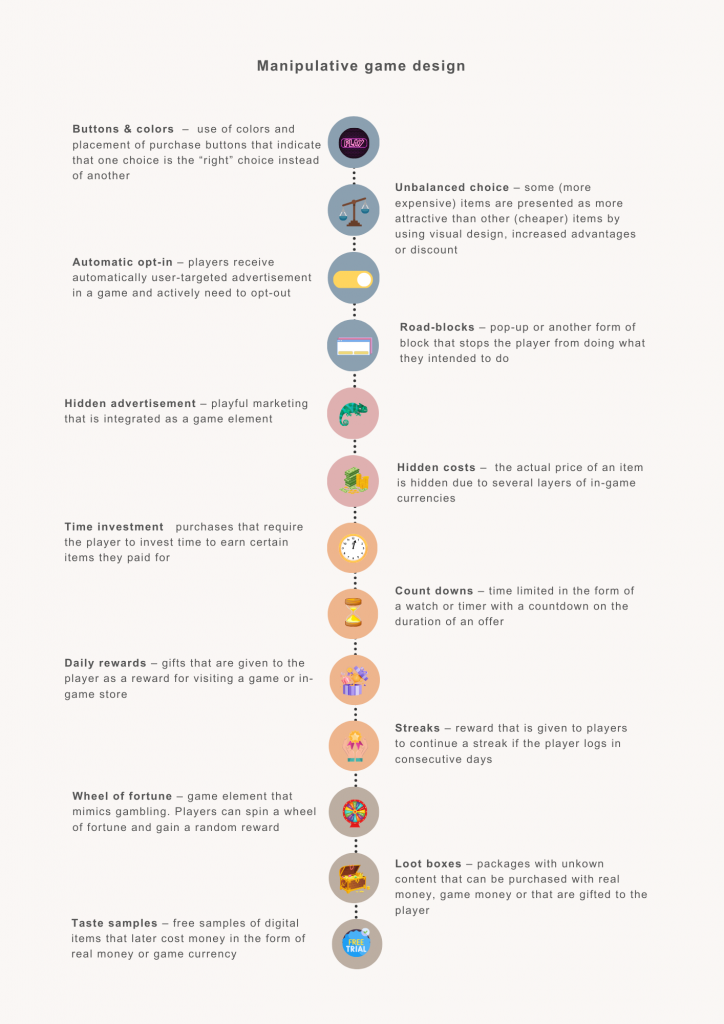From digital playground to dark patterns
by Clara J. Reich & Kamilla Knutsen Steinnes
Video games are important social arenas for children and adolescents in Norway. Playing video games is one of the most popular leisure activities (Medietilsynet, 2022) where young people can meet and hang out with their friends, have fun, learn new skills, feel a sense of belonging, relax, and explore.
In contrast to the positive aspects of video games, recent concerns have emerged about the understudied economic elements that children are required to navigate (e.g. Grimes, 2021). The literature highlights ongoing trends within the video game industry toward developing new revenue models through an increased sale of virtual products (Wardyga, 2023). New revenue strategies and in particular “dark patterns” have been argued as problematic. But what are dark patterns? How can they be researched and what do they look like? And what can be done about them?

Dark patterns
The Norwegian Council (2022) writes that dark patterns, also referred to as manipulative design, aim to guide, deceive, or pressure consumers to make choices that are mainly beneficial for the business and not the consumer. The OECD (2022) uses a similar term which they term «dark commercial patterns». They describe them as an economic practice that uses elements of digital choice architecture to hinder or disrupt consumer’s choice, autonomy, and ability to make informed choices. This often intends to encourage the consumer to leave more time, money, and personal data in digital platforms than planned. In video games, this is also called «dark game design patterns” which are used intentionally by game developers (King & Delfabbrio, 2018).
Researching manipulative design in video games
In the “Pay-to-Play” project, manipulative design in video games was studied through a nethnographic approach. Specifically, three commercial video games that are popular among children and adolescents in Norway were mapped. This involved a mapping of the items for purchase and an analysis of the game interfaces related to purchasing. To better understand young people’s perspectives, 19 play-along interviews were conducted. The participants were aged 10-15 and lived in different parts of Norway.

What does manipulative design in video games look like?
In the games, thirteen manipulative design strategies were mapped. These were grouped into four major categories.
- Visual design
- Unclear labeling
- Time-based elements
- Gambling mechanisms

This illustrates that manipulative design can take many shapes and be combined with various techniques to make players spend more time and money than intended in video games. Yet, it should be noted that not all video games have (all) manipulative design strategies and sometimes it can be challenging to distinguish between manipulative and engaging design. Further, it should be noted that some video games have fair design or what can be called “anti-manipulative design”.
What to do about dark patterns?
As video games are an important social arena it is important to ensure that young people can safely navigate them. Here are three suggestions that might contribute towards this goal:
- Increasing both parents and their children’s level of digital competence especially their critical consumer competence to better navigate unpleasant social encounters and manipulative design in video games.
- There is a need for policymakers to regulate manipulative design to better protect consumer rights. As many popular commercial video game companies are international, we suggest that laws should be developed across national borders to ensure their effectiveness.
- Further research is needed to gain a more detailed understanding of how manipulative design works in different games, which effect it has, and how it can be distinguished from engaging design.
Interested in more?
Check out the Norwegian report or extended English summary of the report mapping manipulative game design and the report on the role of kids’ consumption in video games and how it influences social relations. You can also read Kamilla’s piece on Pay-to-play? Belonging through consumption in commercial games on the Belong blog.
Authors’ bio
Clara Julia Reich and Kamilla Knutsen Steinnes are Ph.D. candidates at Consumption Research Norway. They research young people’s digital everyday lives from a consumption research perspective.
References
Forbrukerrådet. (2022). Insert Coin How the gaming industry exploits consumers using loot boxes.
Grimes, S. M. (2021). Digital playgrounds: the hidden politics of children’s online play spaces, virtual worlds, and connected games. University of Toronto Press.
Medietilsynet. (2022). Spillfrelste tenåringsgutter og jenter som faller fra – Slik gamer barn og unge.
King, D. L., & Delfabbro, P. H. (2018). Predatory monetization schemes in video games (e.g. ‘loot boxes’) and internet gaming disorder. Addiction, 113(11), 1967-1969. https://doi.org/10.1111/add.14286
Wardyga, B. J. (2018). The Video Games Textbook: History • Business • Technology. Milton: A K Peters/CRC Press. https://doi.org/10.1201/9781351172363